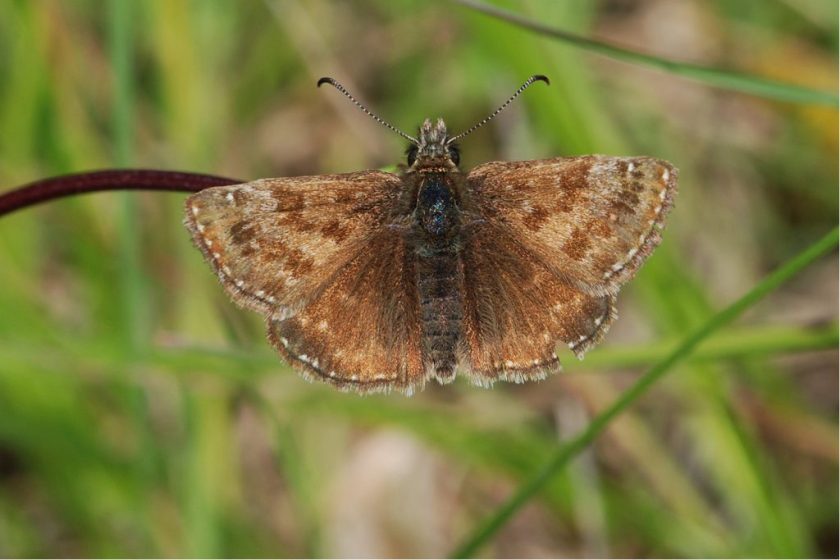The UFZ scientists have produced a unique Grassland Butterfly Index for Germany, which will be crucial in implementing the EU Nature Restoration Regulation. This regulation, which came into effect in 2024, aims to halt species loss and preserve important ecosystem services provided by agricultural landscapes.
Collaborating with the Senckenberg German Entomological Institute (SDEI), researchers at the Helmholtz Center for Environmental Research (UFZ) have calculated this index – an indicator of biodiversity proposed in the EU regulation. The results, published in Nature Conservation, show a negative trend over recent years. The team used 4 million observation data collected over 20 years as part of the ‘Butterfly Monitoring Germany’ program at UFZ.
the Importance of Restoring Agricultural Landscapes
Agricultural landscapes are among the most degraded habitats globally. Restoring them is crucial for halting global biodiversity loss and preserving essential ecosystem services. “The Nature Restoration Regulation (NRR) is an essential instrument for achieving restoration targets set by the European Union,” says Prof. Josef Settele from UFZ.
The objectives include increasing biodiversity in agricultural ecosystems while considering climate change, rural area needs and enduring agricultural production (Article 11 of NRR). To implement these goals, member states must develop national restoration plans and implement concrete measures in terrestrial, freshwater, coastal and marine habitats.
Calculating Indicators to Measure Progress
To determine if specific measures are effective and ecosystems are developing positively under NRR guidelines, indicators will be used. For agricultural landscapes these include:
- The grassland butterfly index
- The stock of organic carbon in cropland mineral soils
- The share of agricultural land with high diversity landscape features
The EU regulation calls for an upward trend towards a satisfactory level by 2030 for at least two of these three indicators. Josef Settele argues that all EU countries should start by recording all three indicators to ensure none are prematurely dropped due to varying natural conditions and land management practices.
Introducing the Grassland Butterfly Index for Germany
A research team led by UFZ has calculated one of the three indicators, the ‘Grassland Butterfly Index’, for Germany and published the results in Nature Conservation. The data comes from Butterfly Monitoring Germany (Tagfalter-Monitoring Deutschland – TMD), a long-term program coordinated by UFZ and the Society for Butterfly Conservation (GfS). Volunteers count butterflies using a standardized European method every week during summer at fixed locations.
“As its launch in 2005, around four million data records have been collected through TMD, providing valuable details on butterfly population trends in Germany,” explains biologist Elisabeth Kühn, who coordinates German Butterfly Monitoring at UFZ.
What Does the Index Show for Germany?
The ‘Grassland Butterfly Index’ tracks populations of 15 butterfly species considered typical inhabitants of various grassland biotopes from 2006 to 2023.The results show a negative trend over recent years.
Butterfly Trends in Germany: A Thorough Analysis
The study conducted by bioinformatician Alexander Harpke and his team reveals that out of the 15 indicator species, four have shown an increase, five have declined, and for six species, the trend is uncertain due to insufficient data.This analysis was carried out over a period of ten years (2006-2016) and shows a slightly positive trend for Germany as a whole. Though, recent years (2016-2023) have seen a critically important decline in butterfly populations.
The decline mainly affects specialized species such as the Small Blue (Cupido minimus) or the Dingy Skipper (Erynnis tages),while generalist species like the Small Copper (Lycaena phlaeas) or Meadow Brown (Maniola jurtina) are less affected.
This trend in grassland butterflies in Germany is consistent with that at European level, as reported by Butterfly Conservation Europe in 2025 for all 27 member states.

The Importance of Butterflies as Indicators
Butterflies are highly sensitive to changes in their environment, notably land use. The loss and fragmentation of habitats have a negative impact on butterfly populations, while intensive mowing, nitrogen inputs, and pesticides contribute to habitat degradation and increased mortality. Species that rely on specific habitats such as nutrient-poor grasslands also suffer from a lack of use due to grazing or mowing.
In addition to land use, climate change is also playing a significant role in the decline of butterfly populations. higher temperatures favor the spread of heat-loving or tolerant species while those adapted to cooler conditions are declining.
These dependencies make butterflies excellent indicators for the state of our ecosystems. They are also easy to monitor by qualified volunteers, providing valuable data for scientists to calculate trends and indicators for reporting under European environmental legislation.
The significance and representativeness of these indicators could be further enhanced by integrating government programs such as Habitats Directive monitoring or nationwide insect monitoring into the analysis,” says UFZ biologist Dr Martin Musche, co-author of the study. This would also apply if data from neighboring countries were included.
Funding Information
this publication was funded by UFZ and gfs (Gesellschaft für Schmetterlingsschutz), as well as by the National Monitoring Centre for Biodiversity (bfn) through the FAMos project, with funds from the Federal Ministry for the Environment, Climate Protection, Nature Conservation and Nuclear Safety (BMUKN).
Publication
Harpke A, Kühn E, Schmitt T, Settele J, Musche M (2025) the Grassland Butterfly Index for Germany. Nature Conservation 59: 315-334. https://doi.org/10.3897/natureconservation.59.162812
Further Information
Follow Nature Conservation on Bluesky and Facebook.


Understanding these indicators is crucial for protecting our planet’s ecosystems.